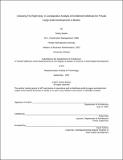| dc.contributor.advisor | Peter Roth. | en_US |
| dc.contributor.author | Baskin, Dmitry | en_US |
| dc.contributor.other | Massachusetts Institute of Technology. Dept. of Architecture. | en_US |
| dc.date.accessioned | 2008-09-02T17:52:31Z | |
| dc.date.available | 2008-09-02T17:52:31Z | |
| dc.date.copyright | 2007 | en_US |
| dc.date.issued | 2007 | en_US |
| dc.identifier.uri | http://hdl.handle.net/1721.1/42035 | |
| dc.description | Thesis (S.M. in Real Estate Development)--Massachusetts Institute of Technology, Dept. of Architecture, 2007. | en_US |
| dc.description | This electronic version was submitted by the student author. The certified thesis is available in the Institute Archives and Special Collections. | en_US |
| dc.description | Includes bibliographical references (leaves 52-55). | en_US |
| dc.description.abstract | In order to keep up with changing urban landscapes, zoning regulations need to be altered and revised to maintain the most appropriate land use. Boston, Massachusetts is a city that has experienced considerable demographic evolution in the past 100 years. In efforts to remain current with the growing and changing needs of the commercial and residential community, developers have employed various methods to permit their projects. Specifically for large projects that do not conform to the underlying zoning constraints, entitlements can be obtained via zoning variances & special permits, creation of a Planned Development Area, a map amendment changing the zoning designation of their site, or use of a Chapter 121A agreement. Each of these methods can be used under specific conditions, relating to the project's context, size, location, and dimensions. Four case studies are presented which highlight the individual entitlement methods; data was obtained via interviews with the developers, Boston Redevelopment Authority staff, industry attorneys, and consultants involved in the case projects. Since the procedures for obtaining entitlements can be challenging, it is necessary to understand the appropriate path to take in order to select the correct method. A decision tree has therefore been developed to assist in determining the most suitable course based on the specific variables of each project. Although the overall process for permitting a project can be lengthy and taxing, knowing the proper steps to take and maintaining a level of flexibility can greatly assist in attaining a successful outcome. | en_US |
| dc.description.statementofresponsibility | by Dmitry Baskin. | en_US |
| dc.format.extent | 55 leaves | en_US |
| dc.language.iso | eng | en_US |
| dc.publisher | Massachusetts Institute of Technology | en_US |
| dc.rights | M.I.T. theses are protected by
copyright. They may be viewed from this source for any purpose, but
reproduction or distribution in any format is prohibited without written
permission. See provided URL for inquiries about permission. | en_US |
| dc.rights.uri | http://dspace.mit.edu/handle/1721.1/7582 | en_US |
| dc.subject | Architecture. | en_US |
| dc.title | Choosing the right way : a comparative analysis of entitlement methods for private large-scale developments in Boston | en_US |
| dc.type | Thesis | en_US |
| dc.description.degree | S.M.in Real Estate Development | en_US |
| dc.contributor.department | Massachusetts Institute of Technology. Department of Architecture | |
| dc.identifier.oclc | 228656955 | en_US |
